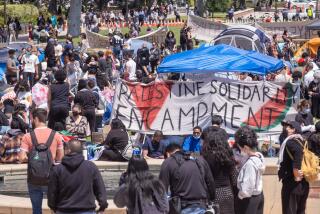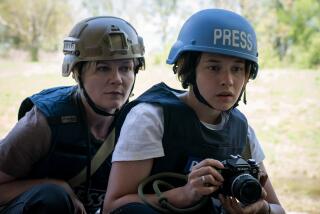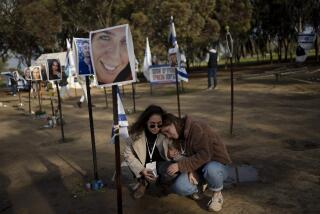Enough to Keep the Mind Alive : NONFICTION : BLOCKADE DIARY,<i> By Lidiya Ginzburg</i> .<i> Translated from Russian by Alan Myers</i> .<i> Introduction by Aleksandr Kushner (HarperCollins: $24; 114 pp.)</i>
John Updike compares the creative writer to a mariner who sets a course out to sea (in contrast with the critic, who hugs the shore). On rare occasions in history, though, literature requires something beyond course-setting.
There are eras of such protracted cataclysm that they bend the straight compass-heading into a curve. Navigation becomes circumnavigation. Dismasted by the storm, the writer has blown so far that he or she is seen heading into port, some ragged morning, from the opposite direction, with a cargo of discovery altered, irradiated, by the round-world journey.
There was such a literary generation in Russia. It caught extravagant fire in the modernisms of the early 20th century. It was tossed about in the fearful energies of the revolution, with its confused twin beacons of artistic hope and destruction. It was trampled and frozen in the long Stalinist winter.
A few figures prevailed, though not all of these survived. “If one lives in Russia,” the saying goes, “one needs to live long.” Because of their intransigence, they became something more than great writers, and because of their literary splendor, something more than great dissidents. They are close to being the saints not only of Russian, but of world literature.
Among them were the poets Anna Akhmatova, Osip Mandelstam and Marina Tsvetayeva and other figures who, if less memorable, still managed to suggest the Earth’s curvature. They maintained the faith that below the horizon lay more than the immediate sight-lines of the oppressive evil they endured and the oppressed good they stood for. Their ordeals--as well as the tactile growl of Russian--allowed them to say “universal truth” and “eternal beauty” and make the loftiness as grainy as black bread. They inspired a younger writing generation, some of whom, like the late Josef Brodsky, inherited a portion of their moral simplicity and their artistic complexity.
One such elder figure, an Akhmatova contemporary, was Lidiya Ginzburg, a literary scholar and critic who died in 1990 at the age of 88. Her “Blockade Diary,” suppressed until the mid-1980s, is a meditation on the 900-day siege of Leningrad by the Germans. Many died in the bombings and shellings; many more--hundreds of thousands--died of disease and malnourishment.
Her journal, though acutely and poetically observed, is not mainly a record of the horrors themselves but more a rumination on their psychological and moral implications. Evoking the daily details of the siege, Ginzburg captures them and transforms them.
There are the German raids--punctually at 8 each night--and the artillery bombardment. Taking shelter was a kind of anesthetic. “It was the beginning of a procedure, the safe ending of which had been proved every day in practice. Many even thought that it was the action of descent and sitting in the cellar that guaranteed a happy outcome; it never occurred to them that this time the house might have survived just as well if they had stayed upstairs.”
Fear was abstract: “Death can be successfully repressed for the very reason that it is not susceptible to experience.” But the abstraction had its oddities: the gaping holes in the building facades, for instance, exposing wallpaper and bits of furniture 50 feet overhead. It produced a new attitude toward one’s own apartment and its precarious suspension in space, Ginzburg writes. People counted, calculating “how many storeys would protect them and how many would fall on them.”
There was a new sense of the city as well; you divided it mentally into zones, some relatively safe, others subject to bombardment. “Crossing a bridge meant entering a zone of altered possibilities.”
Against these abstractions there was the daily reality of slow starvation. Ginzburg writes of it as an alienation of the spirit from the body. “The will was becoming involved with things it had not been concerned with since it was born”--sitting, standing, putting on galoshes, walking one effortful step after the next. Instead of the body hauling the spirit around it was just the opposite.
Fetching a bucket of water up the icy steps from the basement, Ginzburg writes, “you measure the rearing staircase space you will have to cross using willpower and your own body to ferry that water.” The day is a series of spaces to be measured, above all, “the space separating you from dinner.”
The daily weakening battle for food was a minute-by-minute obsession. Ginzburg writes of the “well-organized system of undernourishment” administered, by ration ticket, in the canteens and food stores. The attendants wore white uniforms and everything had the orderliness of a hospital “where by now you are not hating your illness but whatever it is that wants to save you from it.”
She writes acutely of queues, their etiquette, their unbearable tension and why men found them harder than women did. Men were used to thinking that they were important and that their time was valuable, she explains. She writes of the unconscious gestures--similar to the movements we make watching a race--with which people followed the trembling of the scale needle measuring out their bit of bread. There is a grandeur, an artistic will to prevail, in Ginzburg’s recording of these and other details. But the heart of the journal lies in her broader reflections. Ginzburg constructs a composite personage whom she calls “siege man, an intellectual in exceptional circumstances.” The austere formulation has enormous compressive force. “Blockade Diary” offers an alternative figure to the existential hero then being formulated in Western Europe. “Man against the void” was a luxury that Leningrad could not afford. The void was literal, not metaphysical. It was starvation--what had to stand “against” it was communal survival.
The theme of her journal is “the intellectual accommodation of suffering.” It was in the winters, she notes, the most terrible times in the siege, that Leningraders found themselves in some sense the most sustained. “Suffering dislodges suffering,” Ginzburg writes. “Suffering continually strives to be rid of itself with the aid of a different, surrogate suffering.”
Under siege, speculations about the meaning or meaninglessness of life were “cheap talk,” she writes. “Let us recall the life stories of our friends. Every one of them has had so many more opportunities of not existing than the opposite that it is out of the question for him to speculate now on the vanity of existence.”
Surviving in community was not pretty; revulsion, even from family members, went with devotion to them. “So painful, so fearful, was it to touch one another that in propinquity, at close quarters, it was hard to distinguish love from hatred.” Yet there was remarkable solidarity. “Wrung out with pity, or cursing, people shared their bread. Cursing, they shared it; sharing, they died.”
And in a spacious tribute to the human spirit--this most rigorous intellectual and aesthete had to travel the long curve of history to make it--she writes:
“The people of besieged Leningrad worked (while they could) and saved (if they could) both themselves and their loved ones from dying of hunger. It was an essential part of the war effort because a living city barred the path of an enemy who wanted to kill it.”
More to Read
Sign up for our Book Club newsletter
Get the latest news, events and more from the Los Angeles Times Book Club, and help us get L.A. reading and talking.
You may occasionally receive promotional content from the Los Angeles Times.






